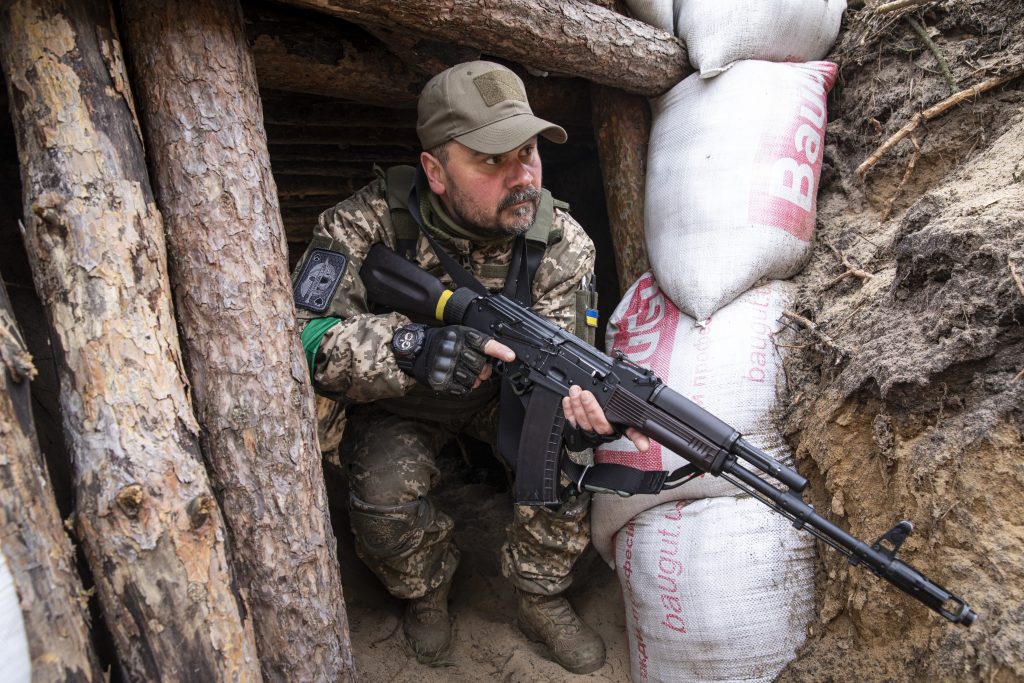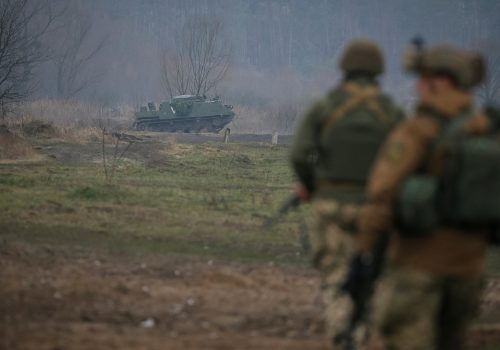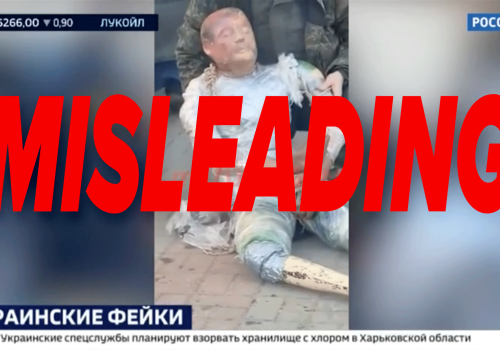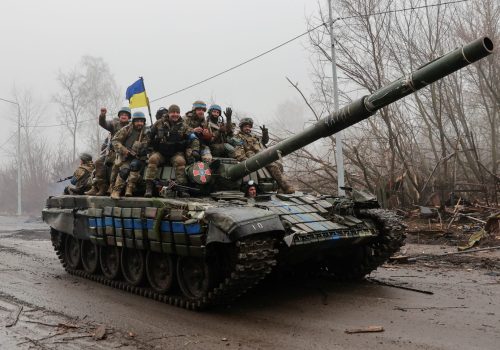In light of the ongoing Russia crisis, the Scowcroft Center’s Forward Defense (FD) practice will share regular assessments of the latest force developments surrounding Ukraine, leveraging the expert perspectives of our senior military fellows. The opinions, conclusions, and recommendations expressed or implied here are solely those of the authors and do not represent the views of the Department of Defense or any other US government agency.
The bottom line
On March 25, Russia was forced to announce a major shift in strategy due to unsustainable losses in northern Ukraine. Since then, it has removed many of its forces from the area—including all those surrounding Kyiv—to Belarus and Russia to refit and reequip. We assess that Russian operations are now centered on the consolidation of gains in the eastern Donbas region and the completion of a land bridge from there to Crimea, which would give Russian diplomats a stronger hand in peace negotiations. If Russian forces gain complete control of the Donbas, not just separatist-held portions, they are in a better position to demand autonomy for the entire region—which then would become a protectorate of the Union State of Russia and Belarus. Controlling the Donbas would also provide Russian President Vladimir Putin ground to claim that his “special military operation” was a success, protecting ethnic Russians in the region and expanding their living space.
We have determined two immediate focus areas of the Russian offensive. First, the Kremlin wants to take control of (or annihilate) Mariupol, effectively ending Ukrainian opposition to a land bridge connecting Crimea to the Donbas. Second, the Russians are likely to conduct an offensive against the city of Izyum, which lies south of Kharkiv and just north of the Donbas. In response to Russia’s strategic shift, the Ukrainian effort has adapted, becoming more offensive with counterattacks and smaller-scale harassment of withdrawing Russian forces. As Ukraine prepares for a larger fight against Russian forces in the east, its military is in urgent need of weapons that will support an offensive to dislodge Russian forces from Donetsk and Luhansk.
The Donbas campaign
Thousands of front-line troops have departed Ukraine for Belarus and southern Russia, where they are likely reorganizing, reequipping, and preparing for the Donbas campaign. Some have begun their move toward the region, and another long convoy of Russian armor has developed—this time repositioning forces from the Kharkiv area to Izyum.
- Battle for Izyum. A town of approximately forty thousand people in Kharkiv Oblast, Izyum’s location between Kharkiv and the Donbas makes it strategically vital as a location to stage and supply the fight. In late March, Russia consolidated control of the town after an extended and brutal battle. Currently, Russian and Ukrainian forces are fighting in rural areas around it, and a major engagement for control of the town (and the lines of communication running through it) seems likely in the next two weeks. On April 3, video and photographs emerged of a Russian Su-35S fighter jet crashing near Izyum, marking the most advanced aircraft the Russians have ever lost in combat. Aside from the real impact of losing a Su-35S, the location of the loss indicates that the fight for air superiority is shifting to the Donbas.
- Battle of attrition in the Donbas. Ukraine was very successful in the defensive battles of Kyiv and Kharkiv, blunting Russian advances outside of those major cities, attacking logistics supply and reinforcement convoys, and using ground and air fires to destroy Russian equipment and personnel, thereby forcing a withdrawal. But many of the advantages Ukraine harnessed in the battle for northern cities will not be available to them in the Donbas. Not only will Ukrainian forces need to blunt Russian advances, but they will need to dislodge Russian forces from their entrenched positions. We believe this type of battle would lead to a bloody war of attrition, with the line of control moving incrementally.
- Nationwide air and missile strikes. Despite the focus on the east, Russia will continue air and missile strikes across the country to prevent Ukrainian air defenses from focusing solely on the Donbas, inflict physical damage throughout the country, and broadcast a threat to the United States and its European allies and partners not to expand their intervention in the conflict.
Subscribe to our weekly military assessment
Sign up for updates from Forward Defense to hear the latest on the trends, technologies, and military challenges shaping tomorrow.
The Ukrainian offensive
What Ukraine needs. As the conflict shifts from Ukrainian defense of key terrain—a situation that favors the defender—to fighting along a well-established line of control, Ukraine’s capability needs will shift from defensive to offensive in nature. This does not mean that Ukraine no longer needs the anti-tank and air-defense systems that have been so effective thus far; in addition to these, the Ukrainians will need offensive weapons to counter a Russian offensive in the Donbas region and enable a counter-offensive of their own.
- Ground-based fires. As Ukraine looks to prevail in open terrain, it will also need to root out Russian forces from dug-in and well-defended positions—particularly through indirect fires or air and missile strikes. Ukrainian forces will need much more long-range artillery, multiple launch rocket systems (MLRS), and mortars. If deployed in significant numbers, these types of weapons can keep the Russian forces under withering attack, stalling their offensive momentum and potentially dislodging them from dug-in positions.
- Offensive air systems. As the main Russian effort transfers from Kyiv to the Donbas, the Ukrainians must not just contest control of the skies, but also use air power offensively. While the deal for the delivery of MiG-29s from Poland and other NATO nations to Ukraine remains stalled, it appears Slovakia may be willing to donate its MiG-29s to Ukraine (and the United States seems willing to approve). In addition to MiG-29s which can contest Russian air superiority, Ukraine needs aircraft that can be used more offensively, including the ground-attack Su-25 fighter jet and the Mi-24 Hind ground-attack helicopter, both of which are operated by former Soviet NATO members.
- Armored vehicles. As Ukrainian forces transition from a primarily defensive to offensive posture, they will need more armored vehicles to protect their forces and bring mobile fires to the front lines.
- Anti-ship systems. Russia still controls the northern Black Sea, cutting off Ukraine from resupply by sea and allowing the Russian Navy the ability to target coastal cities, including Odesa. Last weekend, the United Kingdom announced its decision to transfer Harpoon anti-ship missiles to Ukraine. While that’s a good start, Ukraine needs many more anti-ship missiles, as well as naval mines.
Can Ukraine capitalize on the Kremlin’s mistakes? Russia has been plagued by several serious issues—primarily logistics, unity of command, and low troop morale—throughout its campaign. But it has attempted several solutions. First, by concentrating forces in eastern Ukraine, Russia can shorten its supply lines. Second, appointing General Aleksandr Dvornikov, who led the military’s southern campaign (its only real success thus far), as overall commander of Russian forces in Ukraine addresses the leadership issue. Third, a consolidated campaign allows the Russian Army to put its greener, lower performing units in defensive positions in Russian-held portions of the Donbas. There, they will have the advantages of defense that Ukraine enjoyed in the initial stages of the invasion. This is why Ukrainian forces must seize an advantage before it’s too late.
To counter Russia’s newfound solutions, Ukraine needs to employ a mix of fire and maneuver to push Russian forces from Mariupol, preventing the completion of the land bridge from the Donbas to Crimea and liberating its occupied territory west and north of Donetsk before the Russians can consolidate gains. Ukrainian attacks against Crimea and the occupied areas of the Donbas should be primarily indirect fire and air strikes. Ukrainian forces must also avoid indiscriminate artillery shelling to protect their own citizens and to draw a stark contrast between their conduct and that of the Russians; Ukraine has the moral high ground and must strive to maintain it. So far, its proficient use of unmanned aircraft systems (UAS) has demonstrated its ability in precision fires, and it should continue to use UAS as aerial spotters. But if Ukrainian forces attempt a counteroffensive into Crimea or the Russian-occupied areas of Donbas, Ukraine risks overextending itself like Russia did in its overly ambitious multi-axis invasion plan.
US, allied, and partner support
US announces security aid already delivered to Ukraine. On April 7, the US Department of Defense (DoD) released a fact sheet documenting all military aid to Ukraine—which totals $1.7 billion since the start of the war and $2.4 billion in the past fourteen months. Highlights included:
- More than twelve thousand anti-armor systems, including more than five thousand of the FGM-148 Javelin anti-tank missile, which has reportedly proven effective against Russian armor
- More than fourteen hundred of the FIM-92 Stinger man-portable air defense systems, which have already destroyed multiple Russian planes and helicopters in the war
- More than seven thousand small arms and fifty million rounds of ammunition
- Hundreds of Switchblade Tactical Unmanned Aerial Systems, which is known as the kamikaze or suicide drone, as it flies to its target and detonates a small explosive device, and RQ-20 Puma Unmanned Aerial Systems, hand-launched, small UASs used for battlefield intelligence, surveillance, and reconnaissance. Though DoD had previously announced the transfer of UASs, it had not previously disclosed the type and numbers.
As the conflict continues, the United States and its allies and partners will need to continue providing security assistance at this level. The demand for anti-armor and anti-aircraft systems will be nearly insatiable, and those weapons are inflicting devastating losses on both Russian equipment and personnel. DoD has only just begun to send more offensive systems, such as the Switchblade and Puma UASs, but they have the potential to play a pivotal role in expanding Ukraine’s ability to find, identify, and destroy Russian military equipment. To that end, on April 13, US President Joe Biden announced another $800 million in military aid to Ukraine, including “artillery systems, artillery rounds, and armored personnel carriers,” as well as helicopters.
Slovakia transfers S-300 to Ukraine. On April 8, Slovakian Defense Minister Jaroslav Nad confirmed his nation was transferring its S-300 surface-to-air missile (SAM) system to Ukraine, and that the United States was going to deploy a Patriot SAM battery to Slovakia. The S-300 is an extremely capable high-altitude and long-range SAM that is capable of engaging aircraft and missiles and has reportedly been very successful throughout the war so far. The S-300 can be used in conjunction with lower altitude shoulder-fired man-portable air defense system (MANPADS) like the Stinger and the British Starstreak. The high risk posed by the proliferation of MANPADS across Ukrainian forces is driving Russian aircraft to higher altitudes—where they’ll now be more susceptible to the S-300. Because of Ukraine’s familiarity with operating the S-300, the integration of this system has likely already occurred. As the focus of air operations turns east, Ukraine will need to reposition its air defenses to that region and beef them up; more S-300s will allow it to do just that.
FD’s conclusion
The war in Ukraine has entered a new phase: the campaign for control of the Donbas. We predict that this phase of the conflict will be distinct from phase one, with a greater focus on offensives against dug-in combatants as opposed to Ukrainian defense against a large attacking force. The campaign is likely to become a bloody war of attrition with limited territorial gains on either side. This requires a change in the Ukrainian arsenal: In addition to anti-armor and anti-aircraft missiles, which Ukraine still needs in large numbers, offensive weapons—including armored vehicles, ground-based fires, and offensive air systems—will be critical to Ukrainian success.
Check out these military moves and more on our military assessment map here.
Meet the FD team
Today’s briefing is brought to you by senior US Air Force fellow Lt Col Tyson Wetzel and senior US Marine Corps fellow Col J.B. Barranco. The Scowcroft Center Military Fellows Program, housed by the Forward Defense practice, hosts military fellows from participating branches of the US military and the armed forces of US allies and partners each year as part of a twelve-month fellowship program.
Further reading
Wed, Mar 30, 2022
Russia Crisis Military Assessment: Russia is forced to make a major shift in strategy
New Atlanticist By
The main Russian effort is now in the Donbas, where Russia will continue to send reinforcements and resupply in the hope of building on (and consolidating) small gains on the ground.
Wed, Apr 13, 2022
Russian War Report: Russia promotes misleading video accusing Ukraine of using mannequins as casualties
New Atlanticist By
Kremlin-controlled TV network Rossiya 24 broadcast a misleading video claiming that mannequins were being used in Ukraine to stage war casualties.
Sat, Apr 9, 2022
Lend-Lease for Ukraine: US revives WWII anti-Hitler policy to defeat Putin
UkraineAlert By
The United States is reviving the WWII Lend-Lease program which helped defeat Hitler in order to dramatically increase arms deliveries to Ukraine and set the stage for Vladimir Putin's eventual military defeat.
Image: Alexander comes out of the shelter in the trenches with his rifle. As Russia retreated from Kyiv Oblast, and now concentrates the offensive in the eastern part of Ukraine, Alexander (48), Sergey (42), Andrew (41), Oleg (31) and their battalion might send to the Eastern part of Ukraine in a few days to join the battle operation. (Photo by Alex Chan Tsz Yuk / SOPA Images/Sipa USA via Reuters.)



